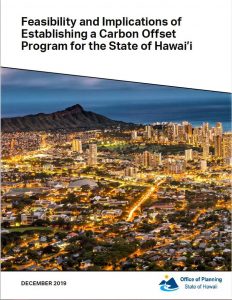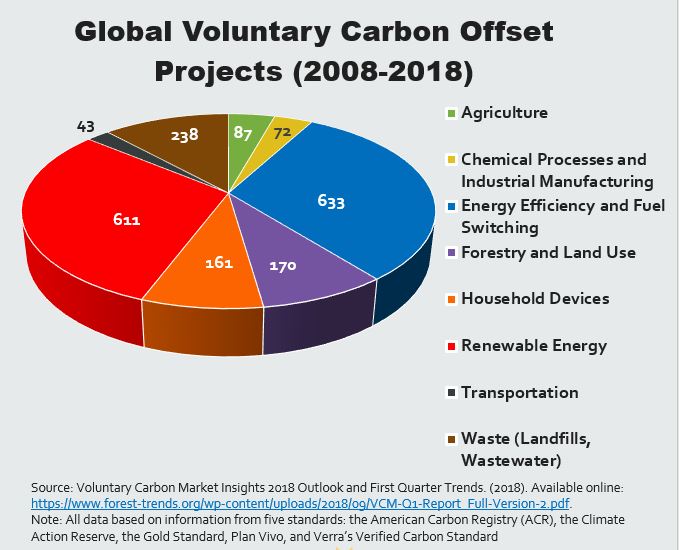Carbon Offset Program Feasibility
The health of our planet depends on the minimization of greenhouse gas emissions. While many governments, companies, and individuals are making major strides by transitioning to cleaner energy, reducing waste, and pursuing other solutions to cut their emissions, these activities aren’t enough to completely eliminate a carbon footprint. When reducing emissions becomes challenging, emitters can utilize carbon offsets which are measurable, quantifiable, and trackable units of greenhouse gas reductions.

Click on the image to open and view the report on the Feasibility and Implications of Establishing a Carbon Offset Program for the State of Hawaii.
Why Offset Carbon and Greenhouse Gas Emissions?
The State of Hawaii enacted Act 32, Session Laws of Hawaii 2017, which committed our state to combat climate change by systematically reducing greenhouse gas emissions and improving Hawaii’s resiliency to climate change by aligning with the principles and contributing to the goals set forth by the United Nations’ Paris Agreement.
The State of Hawaii enacted Hawaii Revised Statutes §225P-6 tasking the Office of Planning to investigate and establish a carbon offset program in partnership with the Greenhouse Gas Sequestration Task Force, through which revenues realized from the sale of carbon offset credits may be invested into projects to generate further carbon offset credits or enhance the State’s mitigation and adaptation to climate change, and are consistent with the State’s sustainability goals and policies.
By investigating a framework for a potential carbon offset program for the State of Hawaii, the offsets from our local sequestration of atmospheric carbon and greenhouse gases combined with Hawaii’s coordinated emission reductions will guide Hawaii to achieve its Zero Emissions Clean Economy Target by 2045, pursuant to Hawaii Revised Statutes §225P-5.
NEW! Please click here to open and view the report on the Feasibility and Implications of Establishing a Carbon Offset Program for the State of Hawaii!
What are Carbon Offsets?
Carbon Offsets are produced by projects that carry-out on-the-ground emissions reductions activities, these projects are typically measured in metric tonnes of carbon dioxide equivalents, or tCO2e. Carbon offsets can either be traded on the voluntary markets, where buyers and sellers trade on their own volition, or through compliance markets, where government regulations require emitters to either reduce their emissions or purchase “allowances” through mechanisms such as cap-and-trade.
Voluntary Carbon Market Standards:
The majority of projects in the voluntary market follow rules and procedures set by voluntary carbon market standards. These serve as core rules and requirements that must be met for any carbon offset project, program, or activity to be certified. If a project meets these criteria, the standard will issue carbon offsets which are equivalent to the emissions reductions. Project developers can then transact these offsets directly to end buyers, who can claim the emissions reductions as their own if they remove the offsets from circulation.
All voluntary standards require that carbon offsets be:
- Real: Evidence that the project actually removes or prevents emissions
- Additional: The emissions reductions would not occur without the project’s activities
- Measurable: The volume of the emission reduction is accurately measured
- Verifiable: A neutral, third-party auditor verified the emissions reductions.
Categories of Voluntary Carbon Projects:
Presently, the most common categories of carbon projects over the past decade were: agriculture, chemical processes and industrial manufacturing, energy efficiency and fuel switching, forestry and land use, household devices, renewable energy, transportation, and waste disposal.
Sustainable Development and Carbon Offset Projects:
While the direct impact of offsets is to deliver climate benefits, many carbon offset projects are able to provide additional impacts called “co-benefits.” Co-benefits align with sustainable development and are often guided by the United Nations’ 17 Sustainable Development Goals by 2030, such as protecting freshwater, supporting the local economy through the development of green jobs, providing access to clean energy, and protecting biodiversity.
What’s My Carbon Footprint?
There are many carbon footprint calculators available online, the United Nations provides a quick and easy Carbon Footprint Calculator to help you determine your own consumption and emissions to learn about your own climate footprint.
